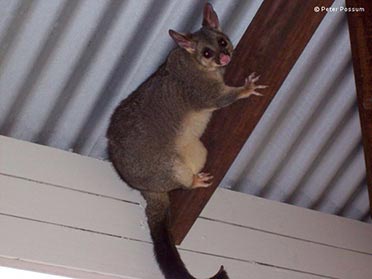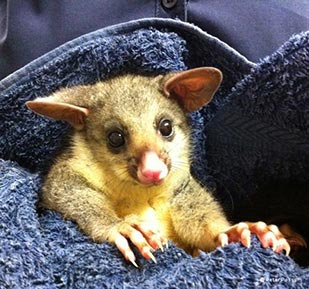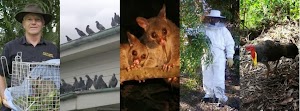All you need to know about Brushtail Possums
Usual name: Common Brushtail Possum
Scientific name: Trichosurus vulpecula – a combination of Greek and Latin words which translates roughly as “Furry Tailed Little Fox”.
SIZE
When fully grown is around 500 to 600mm long for both the male and female of the species. The male possum tends to be slightly larger than the female, similar to the size of a domestic cat.
WEIGHT
When fully grown is around 3 to 4 kilograms.
COAT
Predominantly covered in a soft fur coloured in a “salt and pepper” grey, but has been known to range from browns to blacks with cream colours. The tail fur is black and bushy, hence the name brush tail.
FEATURES
They are a nocturnal marsupial with large eyes suited for night time vision. Its elongated ears are large compared to the size of its body and head, to enable it to pick up the sound of its prey and enemies, when foraging for food.
The most distinguished feature of the Brushtail is its tail, which is a most useful “tool” when climbing trees and branches. It acts as a “fifth” leg to allow quick and safe movement through the tree canopy by wrapping around branches. The Brushtail possum has sharp and strong claws suited to grasping fruit, leaves, small insects and the animals upon which it feeds. It is not a rodent, but has sharp rodent like incisor teeth at the front of its mouth suited to gnawing of leaves, its predominant diet. The rear teeth are larger and suited to chewing and grinding leaves and flowers.
The female has a pouch located on her abdominal region. The pouch is used to carry the undeveloped young for approximately 4-5 months. The young suckles on teats inside the pouch. The male of the species has scent glands located under his chin, down his chest and near the anal area specifically designed to allow him to mark his territory with his strong individual scent. The chest scent glands are most prevalent during the mating season from March to May, when it darkens to a reddish brown “stained” area along the lighter chest fur.
ECOLOGY
The Common Brushtail is widely found throughout the inhabitable regions of the Australian continent including Tasmania. It is largely arboreal (tree inhabiting) marsupial at home in rainforests, eucalypt forests, pine plantations and many types of native bush.
They are extremely adaptable and easily adjusts to life in the urban environments, hence their familiarity with human beings. Being nocturnal (active at night) they are often not noticed by humans but are easy to find if you go looking for them after dusk. During the daytime, Brushtails nest in hollow trees and branches or shelter in thick tree or bush foliage away from predators. They will also use other resources provided by humans such as roof spaces and open-sided garages.
Their diet mostly consists of flowers, buds, succulent leaves and various seasonal fruits. But they are will also sometimes consume insects, bugs, worms, caterpillars and grubs including birds eggs scavenged from nests. The possum will also gladly accept meat into its diet, ranging from small animals to birds and lizards. They are normally a solitary animal preferring its own company to that of a group. It prefers to forage alone and will defend its defined territory and feeding areas.
The female will usually produce a solitary young. It will remain with the mother until 8 to 10 months old. When it is too big to get inside the pouch, the young will ride on the mother’s back for the last 2 to 3 months of its infant life. At approximately 6 months old the young animal called a joey, changes its diet from milk to mainly leaves, flowers and fruit. Before long, the young have the knowledge and skills to leave the mother to go off and claim their own territory (but they usually don’t go far).

Brushtail Possum On a Deck
BEHAVIOUR
The Brushtail communicates with other possums vocally through its varied callings of deep chest boisterous cackling coughing sounds and high pitched staccato hissing noises. These sounds are usually a threatening “be warned” to others that may be encroaching upon the possum’s territory. The sounds are loud and full of energy. There is no mistaking the call of a possum at night time as it fills the night air.
They can also communicate in a passive way with its scent glands, ensuring other possums find its scent spread on the trees and branches of its territory, after rubbing its chest on selective areas.
In rural areas, it is rare for a possum to share a den (its chosen place to sleep) with another possum. It has been recorded that a mother possum will share her den with a daughter possum but only while the daughter is relatively young. Good den sites are usually hard to find hence the competition to keep their den and territory. They are very aggressive fighters when confronted with other possums. They have no hesitation in biting and clawing an opposing possum. The common injuries they will inflict are cuts and abrasions including puncture wounds and gouged hair and skin tears.
In urban areas, when food is plentiful finding more than one possum in a den, is not unusual. In fact, in recent years, it has been more common to find 2 possums in one roof and compared to 10 years ago, finding 3 in one roof occurs more often. This may be due to the size of the roof space, allowing some separation or, in some areas, due to a lack of suitable hiding places.
Territorial disputes are usually between possums of the same gender and fighting occurs less between males and females. When different genders encounter each other, there is usually a peaceful truce between the animals. As a sign of acknowledgement the possums will raise their ears in the air and make subtle eye contact.
During the mating season the males will work hard to earn the affection of the female. It has been documented that it has taken the male a month of courtship before the female has become comfortable enough to allow the breeding to take place.
BREEDING
The Brushtail Possums usual breeding season is between March and May. This can vary between locations in Australia where the warmer months in the north can lead to breeding all year round, which is typical of possums in Brisbane. The male mates with a number of females in order to increase their chance of siring many offspring. The more dominant males can sire several joeys in a season while the younger, smaller and less dominant males can miss out altogether.
Females have a standard gestation period of only 16 to 18 days. The single young (joey) that they give birth to measures a tiny 15mm long and weighs approximately 2 grams. After the mother gives birth the baby instinctively crawls over the abdominal fur and into the pouch. Inside the pouch are teats that the joey attaches itself to; in fact when very young the mouth is sealed tightly onto the teat so the joey cannot fall off.
When in the pouch the very young furless joey is called a “pinkie”. The name “pinkie” lasts until the fur develops. The young possum then moves onto the mother’s back at the age of around 3 to 4 months, once it has a full coat of fur.
Females usually give birth to a single young which will attach to one of the two teats located inside the pouch. On rare occasions a Brushtail possum will give birth to a set of twins. When this occurs the additional mouth to feed puts an enormous strain on the mother’s capabilities to feed the young.
It has also been observed that the survival rate of the second young is very low. The larger and healthier of the twins is usually the only one of the litter to survive.
At Peter the Possum Man we once caught a brushtail mother with two joeys inside a Brisbane home at Mitchelton. When captured, the twins were recorded at about half the weight they should have been for their age. So a specialist volunteer carer nurtured the young possums and their mother for several months. All 3 put on ample weight and were later released back into the garden of the house where they originated from. (A story with a happy ending!)
In normal circumstances, the 3-4 month old young brushtail is too big to get inside its mothers pouch and either goes foraging with the mother, riding on her back or is left in the safety of the den while the mother hunts for food. After seven to nine months the young will be mature enough to leave the comfort of the mother and face the world on its own. In fact, they often have to be chased out to find their own home, when mother has a new joey on the way.
The female possum will reach sexual maturity at around one year old while the male of the species sexually matures at the end of their second year of life. The life expectancy of the average wild Brushtail is 13 years.
URBAN WILDLIFE
In early 2011, Peter the Possum Man collaborated with a University of Queensland research project that involved radio tracking possums in urban Brisbane. A radio collar was fitted on a number of possums and they were tracked during their normal foraging trips. This was repeated after they had been evicted from the roof of the house it was using (by sealing off the entry holes into the roof). The tracking before and after eviction showed little change occurred in their movements and foraging patterns; the home range of Brisbane urban possums was found to be typically only a 100 metre radius from their main den but within that range, over 80% knew of a second safe place to hide, usually in the roof of a house only one or two doors away.
Their territorial range varies during the year as food becomes available from different trees however they do not travel great distances. For survival they need to know where to hide, where to find food and how to avoid the dangers posed by owls, dogs, cats, humans and other aggressive possums. So it is illegal in Queensland and most other Territories and States to transfer them to a new area and research from Victoria has shown that the mortality rate of translocated possums is high.
HOME OWNER PROBLEMS
Due to the Brushtail Possum’s ability to adjust to living with humans, it has been labelled as a pest in some areas. It is known to cause damage to tree plantations and regenerating forests and destroy gardens, flowers, fruit trees and to damage buildings. The abundance of possums in Brisbane is probably due to an increased number of spaces for den sites due to human activity and the high food availability from garden plants and trees. Non-indigenous plants in urban gardens are easily consumed by possums as they lack the toxic compounds found in their native eucalypt diet. They are also often fed by local residents further adding to their frequenting houses. The possum finds it very easy to locate food in built up areas from rubbish bins and pet food bowls. It is a “wildlife success” story, but does create some conflicts with human preferences.
In a residential area the roof spaces and wall cavities of houses and garages are ideal hiding places for the possum. The possum will have no hesitation in gnawing or clawing its way into a gap in the wall or roof of a house or garage to find shelter. This is usually much to the dislike of the home owner who only sees the financial cost implication and health risks associated with the possum invading their house. Possum removal becomes the highest priority for the concerned home owner. Possums have been known to carry diseases and to damage electrical wiring, but the main problem is the noise. It’s often described as walking on the ceiling with boots on.
Signs that a possum is using your house, as his house, are a concentration of possum droppings around the eaves or gutters including urine patches and fur deposits at possible entry points. Loud noises such as scratching, rustling and scampering noises in the ceiling or wall spaces is a dead giveaway that a possum has made your home its new den. Under Queensland wildlife laws, the possum must be released within 25 metres of the place where it is caught; relocating it to another area is effectively a death sentence for the possum because it does not know where to hide or find food.
The best way to remove the possum is to engage our professionals to trap the possum or use special devices to get it out humanely. However, it is critical that we firstly seal off all the entry holes, to prevent the same possum or another one from moving back into the “vacant” accommodation.
SUMMARY – HOW CAN WE HELP YOU?
Apart from sleepless nights due to the noise that your new resident possum may make in your ceiling space, there are also the following unwanted risks with allowing a possum to run riot in your biggest investment – your home.
Possums have been known to carry and spread disease. You and your family’s health is your highest priority so humanely removing the possum is essential. By acting quickly and contacting our professional serviceman who specializes in catching possums when you discover you have an unwanted possum in your house, can also prevent expensive damage to your asset.
Every night the possum is an unwanted “tenant” in your house, the chance of it doing more damage to the ceilings, roof insulation, electrical wiring and walls increases as it gets more comfortable in its new surrounds.
Call Peter the Possum Man and ask for one of our friendly servicemen who is a Brisbane possum removalist. Our highly trained pest controllers and possum catchers will attend to your unwanted guest humanely and efficiently. We have over 25 years of experience and we know all of the animal friendly techniques on how to remove an unwanted possum in a prompt and legal way.
We not only remove the possum with the best practices for the animal’s welfare but we will also proof the house and provide a warranty on the effectiveness of the work done.
It is not always easy to get rid of the possum as finding all the entries and exactly where it is getting in requires an experienced person with the right equipment. The repairs to proof the entries must be strong as a determined possum will work hard to get back in to a place it knows is warm and safe.
So if you have a possum loose in your property, call us and ask for your local Brisbane possum removalist.

Baby Brushtial Possum







